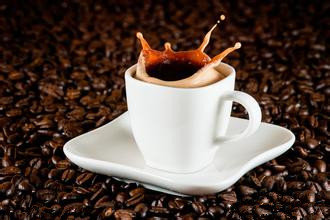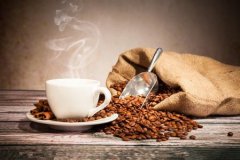Coffee bean roasting principle, fine coffee, general knowledge of coffee.
The small, high-altitude raw Arabica coffee beans are like a warehouse full of chemicals. At present, scientists have identified more than 2, 000 known ingredients, of which 70 to 850 are aromatic ingredients, which can be called the most fragrant in the human diet. There are only 150 kinds of vanilla used for seasoning in the catering industry, and the mellow composition of wine is not nearly as rich as coffee.

Roasting awakens fragrant elves however, the 700 to 800 kinds of fragrant "elves" contained in raw coffee beans will not come out on their own, but must be "awakened" by professional baking. Without this procedure, coffee can only be tasted by the sun or water, and it smells uncomfortable, let alone drink it. After five to 25 minutes of heating, the chemical composition of raw beans has undergone drastic changes, giving off a rare fragrance in the human world. This complex chemical reaction cannot be simulated even in today's most sophisticated laboratories, but it can probably be summed up into several key items.
First of all, after baking raw beans at more than 200 degrees Celsius, the moisture begins to evaporate, the volume expands by 60%, and the weight is reduced by 10% to 25. Depending on the degree of baking, the deeper the baking, the greater the weight loss. No wonder many operators do not like re-baking to save costs. Another important phenomenon is exhaust. Raw beans release carbon dioxide during baking and will continue to exhaust for 30 days after baking. Interestingly, carbon dioxide emissions contribute to the preservation of coffee beans, because oxygen molecules are not easy to invade during the exhaust process, which means that the oxidation that destroys the flavor of coffee cannot be carried out, but the exhaust gradually slows down after seven days of baking. Oxygen molecules are easily attached to the bean table, and the coffee flavor decays quickly, which is an important reason why coffee beans are best used up within a week after opening.
The secret of baking: get the highest caramel and least carbonization. Caramelization is a link that has the greatest impact on the flavor of coffee. After six to seven minutes of baking, raw beans absorb a lot of heat and start the pyrolysis reaction, resulting in the first explosive sound. Some sugars are converted into carbon dioxide, and water continues to evaporate. New aromatic components gradually develop into the so-called coffee oil. And combine with hundreds of aromatic substances such as nicotinic acid, citric acid, quinic acid, malic acid, acetic acid, caffeine and so on. Pyrolysis reaction can continue to the second explosion, although caramelization is an important process to awaken aromatic elves, but with the extension of baking time, some ingredients will also be carbonized to form a bad astringent bitter substance, how to obtain the highest caramelization, but also to minimize carbonization, which seems to be contradictory, but it is the biggest challenge for bakers.
Pay attention to the changes in sound, color and taste. The above chemical reactions can be judged by listening to the sound, seeing the color and smelling the smell. With the continuous heating, the color of coffee beans will change from gray to golden yellow to light brown, and then to a trace of reddish brown out of oil, and then a large amount of oil will show a dark brown of oil. If you continue to bake, the coffee oil on the bean surface will become dry and dead black, and there will be a lot of blue smoke with a burning smell. This is a warning that is close to burning. Prepare to call 119 to help put out the fire. Experienced bakers will choose between light brown to oily dark brown for safety. Coffee beans change from shallow to deep because of changes in caramelization and acidity.
Listening to sound is also the basis for judging the degree of baking. If the temperature of the roaster is hot enough, coffee beans will burst twice during the roasting process. For example, high-temperature-resistant raw beans such as Mantenin and Angelica will burst for the first time in about seven minutes, and the sound will be low and sparse. This means that the "pyrolysis" is started, that is, the starch begins to be converted into caramel, and water is ejected from the bean surface with carbon dioxide, making a low burst sound, which is quiet for two minutes. Around 12 minutes, there was a more violent and sharp popping sound, which was the sound of coffee bean cell fiber breaking, which indicated that the baking was coming to an end, and if it went on, the fragrance would fade. We can see that coffee beans can talk.
Important Notice :
前街咖啡 FrontStreet Coffee has moved to new addredd:
FrontStreet Coffee Address: 315,Donghua East Road,GuangZhou
Tel:020 38364473
- Prev

Basic knowledge of Coffee and Nutrition Fine Coffee
Coffee contains a small amount of nutrients. Every 100 grams of coffee beans contain 2.2 grams of moisture, 12.6 grams of protein, 16 grams of fat, 46.7 grams of sugar, 9 grams of cellulose, 4.2 grams of ash, 120 milligrams of calcium, 170 milligrams of phosphorus, 42 milligrams of iron, 3 milligrams of sodium, 0.12 grams of vitamin B2, 3.5 milligrams of nicotinic acid, 1.3 grams of caffeine and 8 grams of tannins.
- Next

The mixing of coffee beans combines coffee from different places.
First, the mixing of coffee beans people need to combine coffee from different places for several different purposes. The ideal goal, of course, is to piece together a coffee that tastes better than any of them. But generally speaking, Arabica coffee from a single origin is enough to make coffee that tastes good for export; it has a delicate flavor, a soft taste and a sweet aftertaste. So you don't need it.
Related
- Beginners will see the "Coffee pull flower" guide!
- What is the difference between ice blog purified milk and ordinary milk coffee?
- Why is the Philippines the largest producer of crops in Liberia?
- For coffee extraction, should the fine powder be retained?
- How does extracted espresso fill pressed powder? How much strength does it take to press the powder?
- How to make jasmine cold extract coffee? Is the jasmine + latte good?
- Will this little toy really make the coffee taste better? How does Lily Drip affect coffee extraction?
- Will the action of slapping the filter cup also affect coffee extraction?
- What's the difference between powder-to-water ratio and powder-to-liquid ratio?
- What is the Ethiopian local species? What does it have to do with Heirloom native species?

